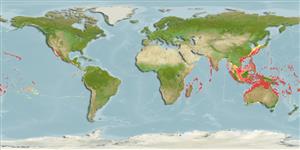Environment: milieu / climate zone / depth range / distribution range
Ekologi
marina revassocierade; djupintervall 9 - 170 m (Ref. 30874), usually 16 - ? m (Ref. 9710). Tropical
Indo-Pacific: East Africa to Pitcairn (excluding Easter Island), north to Japan, south to the Great Barrier Reef. Throughout Oceania. Not recorded from the Arabian Peninsula or the southern coast of Asia.
Size / Vikt / Age
Maturity: Lm ? range ? - ? cm
Max length : 18.0 cm TL hane/ej könsbestämd; (Ref. 48636)
Taggstrålar i ryggfenan (totalt): 5; Mjukstrålar i ryggfenan (totalt): 21-22; Taggstrålar i analfenan 1; Mjukstrålar i analfenan: 17 - 18. Indian Ocean form shows lined versus barred pattern (Ref. 48636). Spinous portion of dorsal fin black at base, deep red distally. A longitudinal row of black spots 8 or 9 subquadrangular red to dark brown spots along back alternating with similar but more vertically elongate red spots on lower side. Two narrow bright red bars at pectoral-fin base (Ref 42740).
Benthic (Ref. 58302). Usually on open sand and rubble substrates near reefs (Ref. 48636, 58302). Adults occur on deep seaward and coastal slopes and deep sand flats (Ref. 48636) at depths to 170 m and rises up to about 15 m to feed (Ref. 90102). Adults have lyre-tail and may swim high above the substrate to feed on zooplankton, usually amongst other fishes such as basslets (Ref. 48636). Minimum depth of 9 m reported from Ref. 30874.
Life cycle and mating behavior
Könsmognad | Reproduktion | Lek | Ägg | Fecundity | Larver
Randall, J.E., G.R. Allen and R.C. Steene, 1990. Fishes of the Great Barrier Reef and Coral Sea. University of Hawaii Press, Honolulu, Hawaii. 506 p. (Ref. 2334)
IUCN Red List Status (Ref. 130435)
Threat to humans
Harmless
Human uses
Akvarium: Kommersiell
Ytterligare information
PopulärnamnsynonymerMetabolikPredatorerEkotoxikologiReproduktionKönsmognadLekSpawning aggregationFecundityÄggEgg development
referenserVattenbrukVattenbruksprofilAvelslinjerGenetikElectrophoresesÄrftlighetSjukdomarBehandlingNutrientsMass conversion
Verktyg
Special reports
Download XML
Internet-källor
Estimates based on models
Preferred temperature (Ref.
123201): 22.4 - 28.8, mean 27 °C (based on 884 cells).
Phylogenetic diversity index (Ref.
82804): PD
50 = 0.5000 [Uniqueness, from 0.5 = low to 2.0 = high].
Bayesian length-weight: a=0.00692 (0.00311 - 0.01538), b=3.06 (2.88 - 3.24), in cm total length, based on LWR estimates for this Genus-body shape (Ref.
93245).
Trofisk nivå (Ref.
69278): 3.4 ±0.45 se; based on food items.
Resiliens (Ref.
120179): Hög, lägsta populationsfördubblingstid mindre än 15 månader (Preliminary K or Fecundity.).
Fishing Vulnerability (Ref.
59153): Low vulnerability (10 of 100).
Nutrients (Ref.
124155): Calcium = 90.6 [48.1, 143.0] mg/100g; Iron = 0.773 [0.480, 1.265] mg/100g; Protein = 17.8 [15.5, 19.8] %; Omega3 = 0.111 [0.065, 0.196] g/100g; Selenium = 39.5 [20.5, 80.9] μg/100g; VitaminA = 142 [52, 416] μg/100g; Zinc = 1.4 [1.0, 1.9] mg/100g (wet weight);
